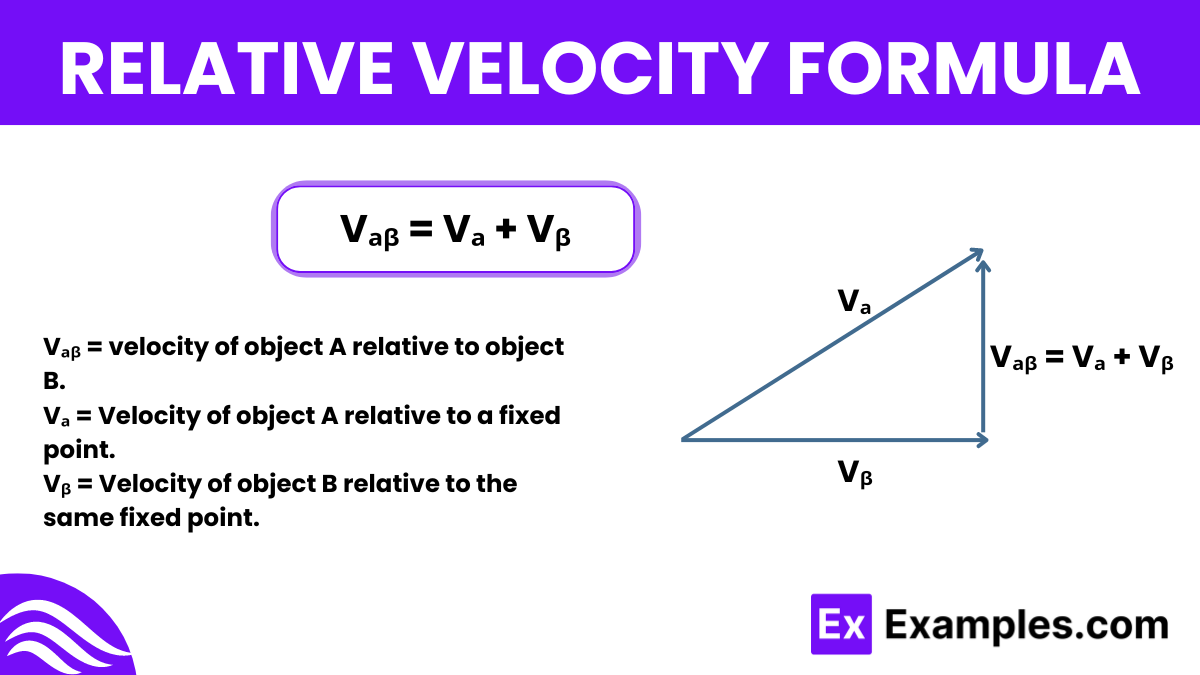If two objects are moving in the same direction, how do you calculate their relative velocity?
Subtract their velocities
Add their velocities
Multiply their velocities
Divide their velocities


Relative velocity is a key concept in physics that describes the velocity of an object or observer A in relation to the velocity of another object or observer B. The relative velocity formula helps in understanding how fast two objects are moving with respect to each other. The formula for relative velocity is expressed as
In simpler terms, to find out how fast two objects are moving towards or away from each other, one can subtract the velocity vector of one object from the other.
The concept of relative velocity was developed as part of classical mechanics, with significant contributions from Sir Isaac Newton. While Newton did not directly coin the term “relative velocity,” his laws of motion and gravity laid the groundwork for understanding motion in a relative sense. The relative velocity formula allows us to solve problems where objects are moving in different frames of reference, making it a fundamental equation in the study of motion.
The derivation of the relative velocity formula begins by considering the concept of velocity itself, which is a vector quantity. This means velocity has both magnitude and direction. When discussing relative velocity, we are dealing with the velocity of one object as observed from another moving object, rather than from a fixed point.
Let’s denote the velocity of object A as Vₐ and the velocity of object B as Vᵦ, both measured relative to a common fixed reference point. The goal is to find the velocity of object A as observed from object B, labeled as Vₐᵦ. To derive the relative velocity formula, we follow these steps:
Consider Object A’s Velocity (Vₐ): This is the speed and direction of A as measured from a fixed point.
Consider Object B’s Velocity (Vᵦ): Similarly, this is the speed and direction of B as measured from the same fixed point.
Subtract Object B’s Velocity from Object A’s Velocity: To find how fast A appears to be moving relative to B, we subtract the velocity of B from A. The formula used is:
This subtraction of vectors accounts for both the magnitude and direction of velocities.
Result Interpretation: The resulting vector Vₐᵦ represents the velocity of object A as it appears from object B. If both objects were moving towards each other, their relative speeds would add up.
When two objects, A and B, are moving in the same direction, their relative velocity is calculated by subtracting the velocity of one object from the other. This is because both objects are moving along parallel paths, and we are interested in their speed difference. The formula is given by:
In this configuration, if Vₐ is greater than Vᵦ , the relative velocity Vₐᵦ is positive, indicating that A is moving ahead of B. Conversely, if Vₐ is less than Vᵦ, Vₐᵦ is negative, meaning A is lagging behind B.
When objects move in opposite directions, their relative velocity is calculated by adding their speeds. This scenario reflects the fact that both objects are contributing to the distance changing between them, effectively increasing the rate at which they separate or approach each other.
Here, Vₐᵦ will always be a positive value, representing the total rate of separation or approach, depending on the context.
Question: Car A is traveling at 80 km/h east, and Car B is traveling at 60 km/h east. What is the velocity of Car A relative to Car B?
Solution:
Use the formula for relative velocity in the same direction: Vₐᵦ = Vₐ + Vᵦ
Plug in the values:
𝑉ₐᵦ = 80 km/h − 60 km/h=20 km/h
Answer: The velocity of Car A relative to Car B is 20 km/h east.
Question: Train A moves west at 70 km/h, and Train B moves east at 80 km/h. What is the relative velocity of Train A with respect to Train B?
Solution:
Use the formula for relative velocity in opposite directions: Vₐᵦ = Vₐ + Vᵦ
Since they are moving towards each other:
𝑉ₐᵦ = 70 km/h + 80 km/h = 150 km/h
Answer: The relative velocity of Train A with respect to Train B is 150 km/h.
Question: Boat A is moving north at 10 m/s and Boat B is moving west at 15 m/s. What is the relative velocity of Boat A with respect to Boat B?
Solution:
Since the boats are moving perpendicular to each other, use vector subtraction to find the relative velocity:
𝑉⃗ₐᵦ = 𝑉⃗ₐ − 𝑉⃗ᵦ
Represent the velocities as vectors:
𝑉⃗ₐ = 10 m/s 𝑖, 𝑉⃗ᵦ = 15 m/s 𝑗
Subtract the vectors:
𝑉⃗ₐᵦ = (10 m/s 𝑖) − (−15 m/s 𝑗) = 10 m/s 𝑖 + 15 m/s 𝑗
Calculate the magnitude of 𝑉⃗ₐᵦ :
∣𝑉⃗ₐᵦ∣ = √(10² + 15²) m/s = √100+225 m/s = √325 m/s ≈ 18.03 m/s
Answer: The relative velocity of Boat A with respect to Boat B is approximately 18.03 m/s in a northeast direction.
The relativistic velocity formula combines velocities using Lorentz transformations, crucial for velocities approaching the speed of light.
Calculating relative velocity helps predict the motion of objects as observed from different reference frames, enhancing safety and planning.
Relative velocity measures how fast one object moves in relation to another, simplifying understanding of motion interactions.
Text prompt
Add Tone
10 Examples of Public speaking
20 Examples of Gas lighting
If two objects are moving in the same direction, how do you calculate their relative velocity?
Subtract their velocities
Add their velocities
Multiply their velocities
Divide their velocities
If an object A is moving at 10 m/s and object B is moving at 5 m/s in the same direction, what is their relative velocity?
15 m/s
5 m/s
10 m/s
20 m/s
When considering relative velocity, what reference frame is typically used?
Absolute frame
Relative frame
Inertial frame
Accelerated frame
What is the significance of relative velocity in collision problems?
Determines force
Determines displacement
Determines velocity difference
Determines impact speed
In an airplane moving north at 200 km/h, a person walks east at 5 km/h. What is the person's velocity relative to the ground?
200 km/h north
205 km/h east
200.1 km/h northeast
200.06 km/h northeast
If car A moves at 60 km/h east and car B at 40 km/h west, what is the relative velocity of car A with respect to car B?
20 km/h
100 km/h
40 km/h
60 km/h
How does relative velocity affect the observed speed of objects in different frames of reference?
It remains constant
It varies
It decreases
It becomes zero
What is the relative velocity of two objects moving parallel to each other at the same speed?
Equal to their speed
Twice their speed
Zero
Half their speed
In the context of relative velocity, what does the term "reference frame" mean?
A stationary point
A moving point
A point of observation
A fixed point in space
What is the effect of relative velocity on time perception in different frames of reference?
Time speeds up
Time slows down
Time remains the same
Time is irrelevant
Before you leave, take our quick quiz to enhance your learning!

